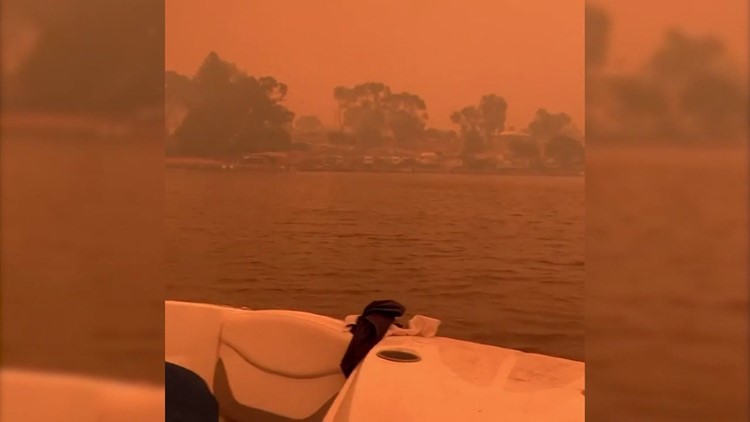VICTORIA, Australia — Thousands of people had to take refuge from wildfires on a beach in southeast Australia on Tuesday morning, having fled their homes as fires swept through the town.
Early in the morning, about 4,000 residents and visitors were forced to leave their homes and vacation accommodation in Mallacoota, in the state of Victoria, authorities said.
The town activated its emergency siren warning of the imminent fire threat and residents headed to the seaside, following an evacuation plan previously outlined in community meetings.
“There’s no way in or out,” Mallacoota resident Jason Selmes told CNN after evacuating his home.
Thick smoke from the fires turned the morning sky pitch black. As the day wore on, the sky lightened to a bright orange, and the blazes began spreading through the town. Photographs from the ground showed homes burning and an approaching fire line.
Some people sought shelter in the sea. Ida Dempsey and her family were visiting from Melbourne, and evacuated to their boat, mooring about 200 meters (about 656 feet) from shore.
Three emergency strike teams were at the beach with the residents, and emergency services set up medical centers and safe evacuation locations, according to state agency Victoria Emergency.
Conditions became milder later in the afternoon after a dangerous wind change bypassed the town. Country Fire Authority Chief Steve Warrington said it was “relatively good news,” and that evacuees had cheered upon hearing the announcement.
Some people are now returning to their homes, while others remain on the beach. There are “a number of houses” believed to be destroyed or damaged, Warrington said.
However, the situation remains “dynamic and dangerous,” and Warrington said there is still an emergency warning in place. A number of fires remain burning in the town and across the state that could spread across the East Gippsland region where Mallacoota is located. Warrington warned residents to stay aware of further alerts and added that state authorities were still discussing potential evacuations.
Victoria Emergency Management Commissioner Andrew Crisp said some communities in the state remain isolated, and food packs and other supplies are being organized for transport. Emergency crews are still working to determine the extent of damage by air, but suggest significant property loss across the East Gippsland region, he said.
Four people remain unaccounted for in Victoria with a “very real fear for their safety,” state Premier Daniel Andrews said on Tuesday. He did not provide any further information on identities or exact locations.
Located in the far eastern corner of Victoria, East Gippsland is home to about 80,000 people, who are scattered across remote villages and towns. The region is popular with tourists who go to see wildlife and hike in the national parks.
There is a nationwide fire crisis
As of Monday, there are more than 10 fires in the East Gippsland region alone, including three large ones that have been burning for more than a month, according to Victoria Emergency. Many of the fires were started on Sunday by dry lightning and rapidly spread due to strong winds and hot, dry weather.
On Sunday, Victoria authorities urged residents and vacationers to evacuate, warning that “it is not possible to provide support and aid to all the visitors” in the area.
Weather conditions are expected to improve in the next 24 hours — meaning cooler temperatures and lower winds — but will worsen again by the end of the week, bringing dangerous fire conditions, according to CNN meteorologists.
Fires have devastated parts of Australia for months. Across Victoria, 70 new fires started on Monday, of which more than 20 are still active. In the neighboring state of New South Wales (NSW), there are more than 100 fires burning on Tuesday, of which 60 are yet to be contained.
The death toll has been slowly climbing. Two people were found dead Tuesday in the NSW town of Cobargo, with a third person still unaccounted for. On Monday, a 28-year-old volunteer firefighter died in NSW after strong winds rolled his truck over. Earlier in December, two other NSW volunteer firefighters died after their vehicle hit a tree during firefighting operations.
More than 900 homes have been destroyed in NSW since the start of the fire season, and that number will likely increase as firefighters struggle to contain the massive fires.
In Batemans Bay, NSW, hundreds of families were also evacuating their homes on Tuesday under an eerie orange sky. “It was like we were in hell,” vacationer Zoe Simmons told CNN. “We were all covered in ash.”
NSW Rural Fire Service Commissioner Shane Fitzsimmons warned there are thousands of people along the coast taking refuge with “a long, difficult, dangerous night ahead.” He said that the fires on Tuesday spread faster and further than previously predicted, adding: “it’s been a truly awful day.”
NSW and Victoria are some of the hardest-hit locations, but there have been fires occurring in every state across Australia as weather conditions worsen.
State and federal authorities have activated emergency resources and deployed thousands of firefighters since the fire season began in early September. The Australian Defence Force has sent assistance to multiple states, including air force aircraft and army personnel. The United States, Canada, and New Zealand have also sent additional firefighters to help.



